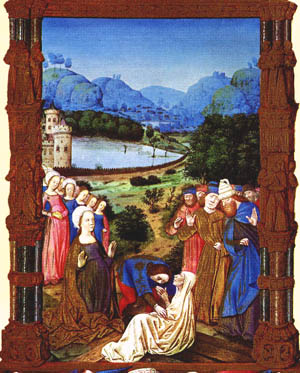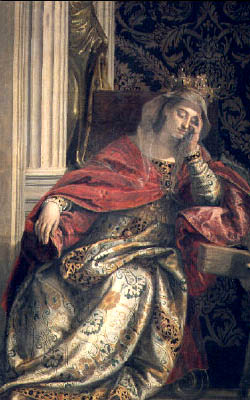 |
The Saint of the Day
St. Helena, August 18
Prof. Plinio Correa de Oliveira
Biographical selection:

The revealing of the True Cross
Tres riches heures do Duc de Berry
|
After her pilgrimage at age 80 to the Holy Land and the finding of the True Cross in 326, St. Helena left Jerusalem. Her return trip to Rome was marked by the many charitable works she performed. She built various churches, made generous donations to others, helped the poor and destitute, consoled the unfortunate, and opened the doors of prisons. The liberation of captives was, indeed, one of her glories.
Her princely munificence was such that, according to Eusebius, she assisted not only individuals but entire communities. She manifested the same piety and benevolence wherever she went throughout her life.
When she arrived in Rome, Constantine gave a grand reception in honor of his mother. On this occasion, she chose to present her son with the precious gift of a small parcel of the Holy Cross. She also gave a large fragment of the Holy Cross to the city of Rome, and later the Santa Croce Basilica was erected on that spot by Constantine to house it at her suggestion.
Her return voyage to Rome was marked by a singular episode. While crossing the Adriatic Sea, the Empress heard accounts of the terrible and numerous drownings that often occurred there. She was so strongly moved by the stories that she took one of four nails that had crucified Our Lord, which she was bringing with her from Jerusalem, and threw it into the depths of the sea. St. Gregory of Tours relates the incident in his book The Glories of the Martyrs and adds that from that day on, the Adriatic Sea lost its furor.
This was the last trip of St. Helena. She died in Rome in the year 330. Constantine and the princes, his sons, surrounded the bed of the Empress, where she gave two last counsels to the Emperor. Her last words were to tell him to watch over the Church and to be just. Finally, she gave him her final blessing; the Emperor was holding her hand when she took her last breath. Her body was brought to Constantinople and buried with great pomp in the imperial vault of the Church of the Apostles. The whereabouts of her relics are uncertain.
St. Helena is a great historical character. Nature and grace harmonized perfectly in her. Raised to the throne in the world, she made Christianity sit on the throne for the first time. Her great beauty that brought her to the attention of Constantius was the means that God used for that end. Her illustrious and venerable name would have marked the beginning of a brilliant era if Constantine had been faithful to grace. No one knows how the course of History might have been if the artists could have also painted a halo over the head of Constantine, if the Emperor, like his mother, would have been canonized.
Comments of Prof. Plinio:
This selection describes the beautiful figure of the Empress as a work of art of nature and grace. She is like those figures in the Byzantine mosaics, such as the ones in Ravenna.

In a dream, the site of the True Cross
was revealed to St. Helena
The vision of St. Helen by Paolo Veronese
|
She was a person gifted with an outstanding physical beauty, which is what drew her to the attention of Constantius Chlorus, future Emperor, who married her. She used her position to influence her son Constantine, the successor of his father. This was how she made Our Lord Jesus Christ symbolically sit on the throne of the Roman Empire. Her two great works were the conversion of Constantine and the finding of the Holy Cross. With the finding of the Holy Cross in Jerusalem, her name became immortal.
Her death had the same high tone as her life. There is no more beautiful scene than an Empress who dies surrounded by her son, an Emperor, and her grandsons, princes, with her hand being held by that of the Emperor who had received from her his glory. She expired advising him to assist the Holy Catholic Church. All this is marvelous and seems to have been taken from the illuminated scenes of a book of hours or a medieval Missal.
Her life in a certain way is symbolized by the episode in the Adriatic Sea. It reflects the idea that was already being spread that the most sorrowful Passion of Our Lord Jesus Christ has the power to tame wild and violent things, making them gentle and docile. This is why a nail driven into the flesh of Our Lord that caused him such atrocious torments has the power to relieve men from their sufferings. So when St. Helena threw one of those nails into the tempestuous sea, it became placid. From that moment on – St. Gregory of Tours narrates – the Adriatic Sea was tamed and drownings were no longer as frequent there as they were before.
What can be said about this miracle? Almost all such miracles of nature are analogies of miracles of grace. A suffering from the Passion of Our Lord received with love in the depths of one’s soul brings peace to the revolted passions, dissolves the storms, and makes passage possible on the most dangerous voyages of life without the risk of drowning.
This means that an act of veneration and tenderness for the infinitely precious Passion of Our Lord that comes from the depths of the soul brings peace to it and orients it along the way of sanctity. It can tame the disordered passions, redirect the bad tendencies, and make the spiritual life tranquil - without drowning. This is the beautiful symbolism of that episode of St. Helena’s life.


  | | Prof. Plinio Corrêa de Oliveira | |
The Saint of the Day features highlights from the lives of saints based on comments made by the late Prof. Plinio Corrêa de Oliveira. Following the example of St. John Bosco who used to make similar talks for the boys of his College, each evening it was Prof. Plinio’s custom to make a short commentary on the lives of the next day’s saint in a meeting for youth in order to encourage them in the practice of virtue and love for the Catholic Church. TIA thought that its readers could profit from these valuable commentaries.
The texts of both the biographical data and the comments come from personal notes taken by Atila S. Guimarães from 1964 to 1995. Given the fact that the source is a personal notebook, it is possible that at times the biographic notes transcribed here will not rigorously follow the original text read by Prof. Plinio. The commentaries have also been adapted and translated for TIA’s site.
|
Saint of the Day | Home | Books | CDs | Search | Contact Us | Donate

© 2002- Tradition in Action, Inc. All Rights Reserved
|
 |

|